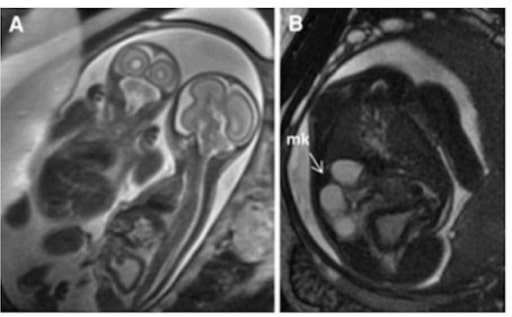Playlist
Show Playlist
Hide Playlist
Horseshoe Kidney
-
Slides CongenitalRenalPathology.pdf
-
Reference List Pathology.pdf
-
Download Lecture Overview
00:01 We'll take a look at this and this is a horseshoe kidney. 00:04 Take a look at that picture, right there. 00:06 Do you see that in the middle? That's a horseshoe. What happened? Inferior poles got fused. What do you think it got trapped under? The inferior mesenteric artery. How often does this occur? Quite. 00:17 And we'll get into that in further detail but I'd like for you to once again put this into context as to, what does could be part of in terms of a syndrome? You all have heard of VACTERL. V, vertebral anomaly, A, anal issues, Cardiac issues. 00:32 T-E, put them together, tracheoesophageal fistula. 00:36 In gastroenterology, we've talked about the most common type of tracheoesophageal fistula and which there's going to be proximal esophageal atresia and distal esophageal fistula. 00:50 85, 95% of your patients have that type of abnormality that we have discussed in gastroenterology. 00:57 Ah, here's my renal. A renal abnormality that you find here with the VACTERL remember please, when you have one continual pathology, you have many, many, many others. 01:06 So, you can't just say that you have just, for example, well, this is one, but then later on, we'll talk about another one with Wilms' tumors okay, WT1 especially. 01:17 And there's another one called coloboma. 01:20 And a coloboma, that will be part of something called charge. 01:23 Okay, so keep in mind that -- and for example, even Down Syndrome, right, Down Syndrome, apart from the fact that your patient might be intellectually disabled, there's gonna be heart issues, right? There's going to be all other types of issues, as well. 01:37 You get my point. 01:38 So whenever you have one congenital issue, understand that there might be many other congenital issues concomitantly. 01:45 So the renal abnormality that I want you to pay attention to here is not renal cell carcinoma, this is not Wilms tumor, this is going to be something like perhaps a horseshoe kidney and then limb abnormalities. 01:58 The limb anomaly here would be something more so commonly found with the radius. 02:02 Welcome to VACTERL, we're looking at a horseshoe kidney. 02:05 Could be a manifestation of an acronym such as V-A-C-T-E-R-L. 02:13 Let's move on. So this horseshoe kidney, the inferior poles have been fused. 02:17 It gets trapped by what? Take a look at inferior mesenteric artery. 02:20 Highlight or keep in mind: I- inferior pole, I- inferior mesenteric artery. 02:26 You're now prone to renal stones. 02:30 Partial fusion as may occur and you might actually have normal functioning. 02:36 Keep that in mind. 02:38 Oftentimes part of autopsy. Horseshoe kidney, most common congenital kidney disorder, the majority of your fusion will be taking place with the inferior poles. 02:46 Trapped behind by what? Inferior mesenteric artery. Clinical finding maybe perhaps part of Turner's syndrome. 02:53 So with Turner's syndrome, even with that, even officially introducing Turner's syndrome, which we will, when we talk about reproductive pathology. 03:01 Well, you have an XO syndrome. 03:04 We talked about coarctation of the aorta already. We already talked about webbing of the neck. 03:08 We'll bring that up again. 03:09 Later on, we'll talk about the ovaries known as dysgerminoma. 03:14 We brought into play the aortic valve which only has two cusps, the bicuspid. 03:18 It may result in a young patient that has what? Aortic stenosis and here, congenitally, could result in renal issues. 03:26 What are we worried about? Infection and stone formation, might not have proper excretion.
About the Lecture
The lecture Horseshoe Kidney by Carlo Raj, MD is from the course Introduction to Renal Pathology.
Included Quiz Questions
What is the most common type of tracheoesophageal fistula?
- Proximal esophageal atresia and distal tracheoesophageal fistula
- Proximal esophageal atresia and proximal tracheal fistula
- Proximal tracheal atresia and distal esophageal fistula
- Distal esophageal atresia and proximal esophageal fistula
- Proximal esophageal hypertrophy and distal esophageal fistula
Which of the following statements is not true regarding horseshoe kidneys?
- Fusion of both poles of the kidneys.
- Higher incidence in Turner syndrome.
- Increased incidence in infections and calculi.
- Most common congenital kidney disorder.
- Fusion of the inferior pole of the kidney.
Which of the following blood vessels is involved in a patient with horseshoe kidney?
- Inferior mesenteric artery
- Internal iliac artery
- External iliac artery
- Inferior mesenteric vein
- Superior mesenteric artery
Customer reviews
5,0 of 5 stars
| 5 Stars |
|
5 |
| 4 Stars |
|
0 |
| 3 Stars |
|
0 |
| 2 Stars |
|
0 |
| 1 Star |
|
0 |




